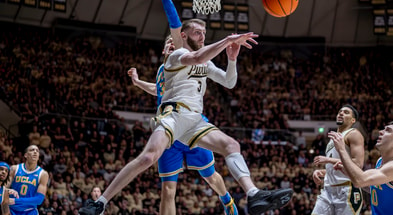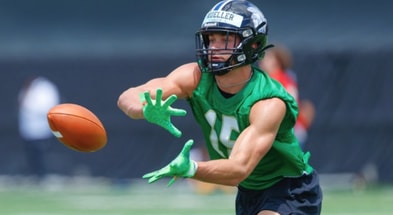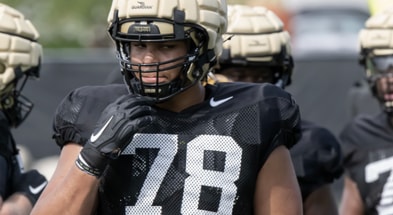Freshman comfort, progress now essential

It wasn’t that long ago that Giccari Harris was flailing as a three-point shooter, to the extent it was almost uncomfortable to watch.
Today, he’s shooting 42 percent from long range in Big Ten play, confident enough to create shots for himself, and make them, like his turnaround jumper just before halftime in Purdue’s narrow win over Indiana Friday night.
“Once I saw two or three threes go in on the road, that’s when I knew I’d be good,” Harris said. “I just tried to stay consistent after that.”
Now …
“Every shot I take, I think it’s going on. That’s what I’ve been trying to get to this whole season.”

It also wasn’t that long ago that classmate CJ Cox‘s inexperience and the tentativeness it might have brought with it showed during Purdue’s non-conference rough spells against heavy pressure.
Since that time, you could count Cox’s turnovers on one hand while noticing the distinct spark he’s given Purdue since becoming a starter the moment Big Ten play resumed nine games ago.
To start the season, the two rookies showed immediately they were ready, but with freshmen “ready” is relative. They were ready to contribute but bound to encounter growing pains, as all freshmen do.
They’ve each come out the back end of those early season difficulties and seem better off because of it.
“You’re going to struggle with something,” Coach Matt Painter said. “Everybody is. How you work through it is really your growth as a player.”
It’s the consummate example of the value of players getting to play through mistakes, because today, Cox and Harris aren’t just minutes-eaters like they may been in November and December. They’ve been difference-makers.
They’re both 40-plus-percent three-point shooters and transition-offense threats, part of a really important component to Purdue’s offensive mix. Neither turn the ball over at a notable rate. Harris is a 94-percent foul shooter in Big Ten play, a luxury at the end of games in particular. Cox has been fine operating as a primary ball-handler when need be, with or without Braden Smith on the floor. His 10 offensive rebounds are third most on the team in Big Ten games.
Top 10
- 1New
Brad Brownell
Clemson HC talks IU rumors
- 2Hot
Chad Baker-Mazara
Bruce Pearl fires back
- 3
UNC resume
'It's like a car accident'
- 4Trending
Nick Saban
Receives FCC criticism
- 5
New Bracketology
Wednesday update
Get the On3 Top 10 to your inbox every morning
By clicking "Subscribe to Newsletter", I agree to On3's Privacy Notice, Terms, and use of my personal information described therein.
“They’re more confident all-around, offensively and defensively” veteran Fletcher Loyer said.
Purdue is winning in a new way right now: By forcing turnovers and scoring off them. That is not what the Boilermakers have been in recent years, but they are now, ever since the resumption of Big Ten play.
This development aligns closely with Harris’ and Cox’s clear settling-in, as their physical and defensive-minded natures may create value that’s more apparent in Big Ten play.
They are most often tasked with pressuring the ball full-court, a years-long staple of Purdue’s defense that has endured through all the changes around it. Again, it is no coincidence that the Boilermakers have emerged as the Big Ten’s most disruptive defense at the exact same time its two freshman guards sort of came of age, on their way to bright futures as Mackey Arena favorites.
Purdue fans tend to appreciate defensive intensity and energy more than other schools’ following’s might.
“The defensive tenacity we have seems to bring a lot of energy to the people in the stands,” Cox said.
It came with its up and downs.
Earlier this season, Harris and Cox applied pressure, but wound up eventually allowing far too many direct drives, compromising their team’s entire defensive structure. There are still breakdowns, but they’re not nearly as common, as the two freshmen have really improved staying in front of the ball.
“In the beginning, me and CJ, I think we were just trying to go crazy on the ball, reaching a lot more and not staying square to the ball,” Harris said. “As (Painter) told us, ‘You just have to be square to the ball and keep the ball in front of you. We’ve been doing a better job recently of just staying in front of the ball and not reaching, staying solid and just trying to let the offense make mistakes. That’s when we can go attack the ball.”
























